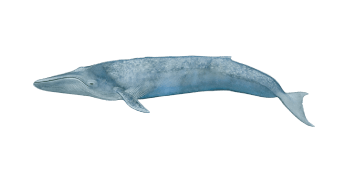
Blue whale
(Balaenoptera musculus)
As far as we know, Blue Whales are the largest animals to have ever lived on earth. Their hearts are the size of a Volkswagen Beetle engine block and their tongues weigh up to 4 tons. Their huge, streamlined body is of a blue-grey color which appears aquamarine underwater.
The mottling pattern, which is often a result of cookie-cutter shark bites, is variable and can be used to identify individuals. Head is U-shaped when seen from above and their dorsal fin relatively small and set far back. Often raise their flukes before diving.
Up to 80 throat pleats, which extend while feeding. Using extremely low frequencies (~10 Hz), Blue whales can communicate with fellow peers over large distances, often up to several hundreds and even thousands of kilometers away.
Their seasonal migrations are complex and not well understood. In general they migrate to tropical waters in winter while in summer they travel to higher latitudes in order to feed.
General information
Further names: Portuguese: Baleia-azul
Size of adults: Northern Hemisphere: up to 29 m; Southern Hemisphere: up to 33 m. Females larger than males.
Prey: Feed almost exclusively on krill, sometimes on pelagic crabs.
Range: Global distribution (except Mediterranean; Baltic Sea). Tend to travel alone or in small, short-lived groups. Sometimes associated with Fin Whales.
Madeira: Solitary animals encountered during the spring months
Distinctive features: Tall, straight spout up to 10 m high. Unique mottling pattern; pale blue to grey primary color. Life span is likely more than 70 years.
Taxonomy: Suborder: Mysticeti (Baleen whales); Family: Balaenopteridae (Rorquals) Two subspecies; B.m. musculus (Northern Hemisphere) and B.m. intermedia (Southern Oceans). There is also a Pygmy Blue Whale: B.m. brevicauda (Indian Ocean).
Threats: Listed as critically endangered for IUCN. Some populations like the Blue Whales in the Antarctic Blue Whale are considered in danger of extinction. Blue Whales were the first baleen whale species to be commercially hunted and this was done so intensively that populations decimated by 99 % of their original stock size. Since 1966 they are under protection but are still caught in some areas, for instance in Japan where their meat is sold under false declaration.
Other threats: Collisions with vessels and free-floating fishing nets. Are one of the primary victims of noise pollution. Estimated global population: 10.000 -25.000 individuals.
